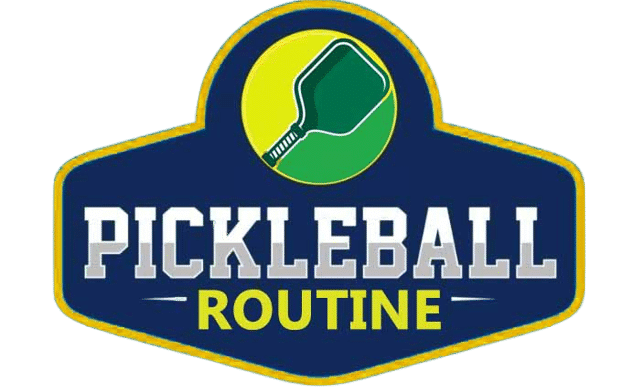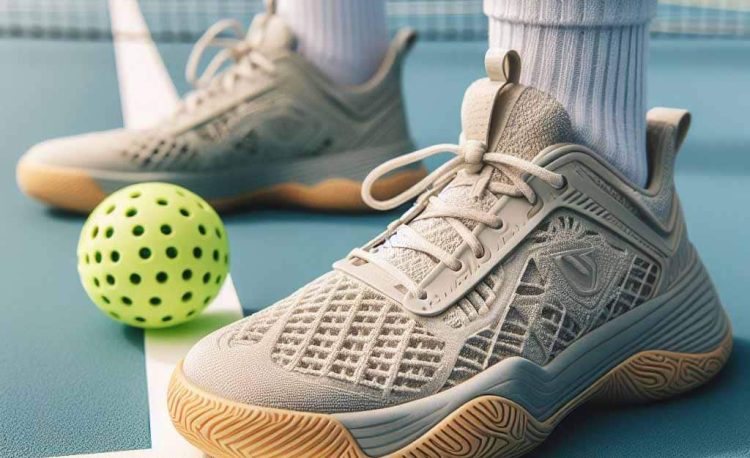Anti-slip pickleball shoes center around three core performance areas: superior traction for grip, lateral stability for quick direction changes, and optimal weight distribution for agility.
Modern pickleball shoes feature specialized rubber compounds and tread patterns that maximize court contact, while reinforced midsoles provide the lateral support essential for the sport’s signature side-to-side movements.
You want strong outsoles with responsive tread patterns and a midsole structure that can handle fast-twitch lateral movements. Weight optimization ensures players maintain quick footwork without sacrificing the durability needed for intensive court play.
Experts from the USA Pickleball Association (2023) recommend court shoes with herringbone tread patterns for best floor contact and slip prevention.
Select shoes with reinforced toe guards, wide bases, and non-marking rubber outsoles.
When selecting anti-slip pickleball shoes, prioritizing traction quality, stability features, and weight characteristics will directly impact your court performance and injury prevention.
The 5 Best Slip-Resistant Pickleball Shoes
| Shoe | Best For | Traction | Stability | Weight |
|---|---|---|---|---|
| Babolat Jet Mach III | Elite performance | High | Strong | Ultra-light |
| K-Swiss Express Light | Value & agility | High | Moderate | Lightweight |
| ASICS Gel Challenger 12 | Support & comfort | High | High | Mid-weight |
| Acacia Tyler Loong Pro | Agility & grip | Very High | High | Lightweight |
| Skechers Viper Court Pro | All-day support | High | Very High | Bulky |
Here are the top slip-resistant pickleball shoes we’ve tested in our court:
1: Babolat Jet Mach III: Best Slip-Resistant Pickleball Shoe for Speed and Stability
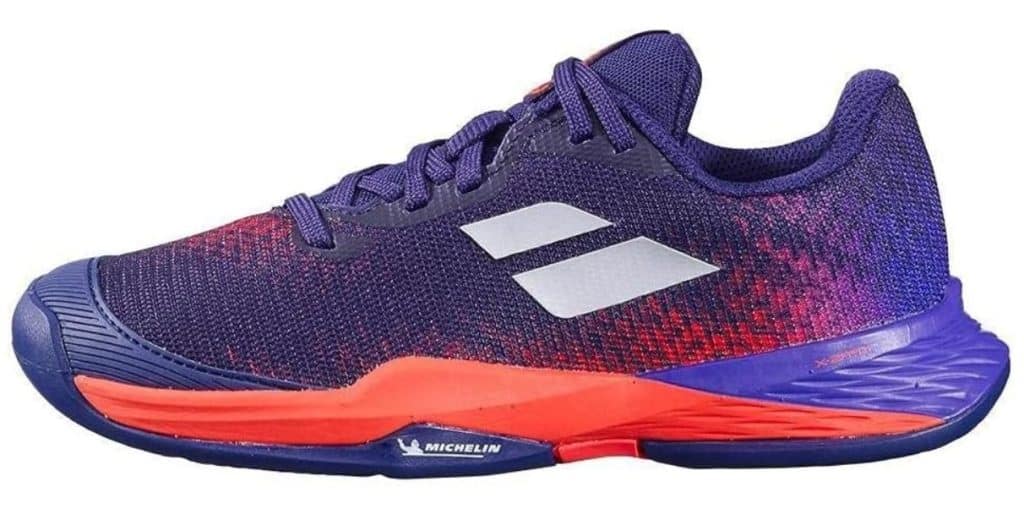
The Babolat Jet Mach III delivers top-tier slip resistance, fast lateral movement, and structured ankle support. Built on feedback from the Jet Mach II, this version improves foot control, durability, and on-court response.
The outsole uses Active Flexion technology, which divides the sole into nine pressure zones to boost reaction time during quick starts and stops.
The tread pattern grips both indoor and textured outdoor courts, reducing fall risk during lateral slides and cross-court sprints.
The Ortholite foam insole cushions the foot while managing moisture buildup during long sessions.
A rigid heel counter locks the ankle in place, while the Matryx Evo woven upper adds strength without restricting movement. This upper uses aramid and polyamide fibers, offering high resistance to deformation under stress.
Torsional stiffness in the midfoot prevents unwanted twisting, especially during aggressive directional shifts.
Airflow on this shoe channels through the forefoot and sides help keep feet cool, even during extended court play.
The lightweight construction keeps fatigue low without sacrificing structural integrity. Fit is snug but not restrictive, best suited for players with medium or narrow feet.
The outsole compound withstands repeated high-friction movements and comes backed by a six-month durability warranty.
While priced in the mid-premium range, its combination of traction, comfort, and support outperforms several higher-cost alternatives. The only drawbacks include thin laces and a soft insole that may flatten over time.
For advanced players needing reliable grip, lateral control, and structural protection, the Jet Mach III remains a top choice in 2025. It’s suited for those prioritizing stability, foot alignment, and rapid transitions over soft cushioning or low weight.
2. K-Swiss Express Light Pickleball Shoe: Best for Grip in Pickleball Courts
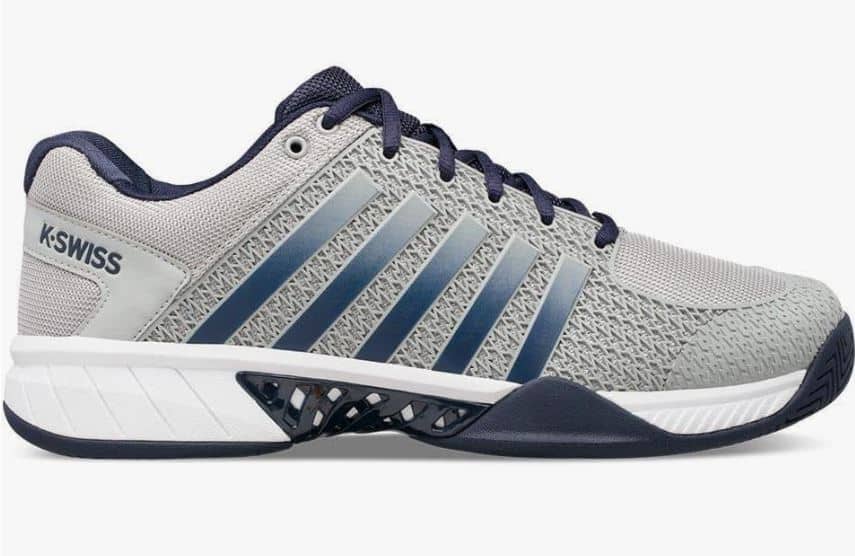
The K-Swiss Express Light delivers lightweight construction, slip-resistant grip, and structured support tailored for pickleball movement. The design prioritizes responsiveness and breathability, combining fast foot transition with moisture control.
The outsole features the Aosta 7.0 rubber compound, engineered for traction and long-term wear on hard courts. A 180-degree plantar support chassis reinforces midfoot stability, which helps players stay grounded during fast lateral moves and split steps.
The Ortholite sock liner manages foot moisture and improves airflow throughout the shoe’s interior. A DragGuard reinforcement in high-friction areas enhances protection against toe drag during net play.
Durawrap layering across the upper adds abrasion resistance without increasing stiffness or restricting foot motion. The heel grip lining prevents internal slippage, improving energy transfer during quick cuts and push-offs.
The shoe supports a neutral arch and fits true to size, though wide-footed players may find it narrow. The low-profile chassis keeps weight down while maintaining a stable base for fast reactions.
Visual appeal supports its court function. The striped upper and color variety give it a sharp, athletic look. Airflow and sweat control remain consistent across long matches, reducing heat buildup and skin irritation.
Despite the light weight, the Express Light holds up under frequent use, thanks to its reinforced chassis and rubber sole compound.
For value-focused buyers, this model offers premium features at a lower price point than other performance shoes. It covers essential needs—grip, comfort, and court-specific durability—without sacrificing quality. While the lack of wide size options limits fit flexibility, its performance-to-price ratio makes it a strong pick for intermediate and advanced players.
The K-Swiss Express Light fits athletes needing fast, breathable, and slip-resistant footwear without high cost. It holds traction well on indoor and outdoor courts and responds quickly under pressure—ideal for players prioritizing mobility and balance in every point.
3. ASICS Men’s Gel-Challenger: Best Affordable Anti-Slip Pickleball Shoes
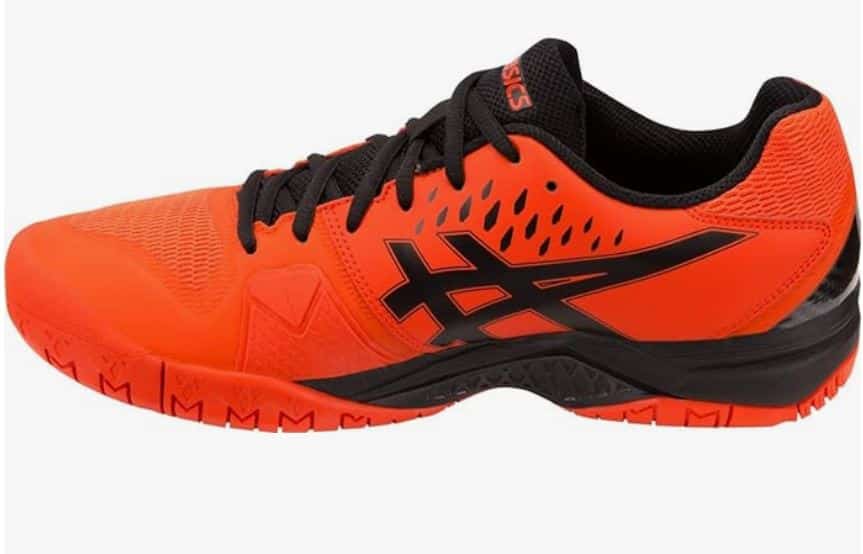
The ASICS Gel Challenger 12 delivers enhanced support, slip resistance, and shock absorption for players managing foot stress or past injuries.
Designed for balance and comfort, it uses SOLYTE midsole material and rearfoot and forefoot GEL technology to absorb high-impact forces during lateral cuts and toe-offs. These features reduce post-match soreness and improve long-session comfort, especially for players with ankle instability or foot pain.
The firm base limits rolling and torsion under pressure, creating a dependable platform during fast, multidirectional play.
Ortholite sock liners increase bounce while managing foot moisture, helping maintain interior comfort over extended matches. The upper fits snug across the midfoot and remains breathable through mesh panels, keeping the shoe cool under stress.
The Challenger 12 performs consistently across both indoor and textured outdoor courts. Grip comes from a high-durability outsole, which targets high-wear areas with extra rubber reinforcement.
Players report confident acceleration and control from the first step, with minimal break-in required. Cushioning levels suit medium to high arches and work well for those needing moderate ankle alignment support.
The design stands out without sacrificing weight or comfort. Color options include bold and neutral tones.
The upper construction manages to maintain visual appeal while delivering structure and protection.
Despite added cushioning and stability features, the shoe keeps weight down and balance even.
At $70, the Challenger 12 offers rare value in the mid-range bracket. Its blend of cushioning, grip, and long-wear stability outperforms several higher-priced alternatives. While it lacks width options, the standard fit accommodates most average feet without pressure points.
The ASICS Gel Challenger 12 suits injury-prone players needing durable shock absorption and lateral support. It maintains grip on various court surfaces while keeping vibration and fatigue low—ideal for players who need dependable comfort without exceeding budget limits.
4. Acacia Sports Tyler Loong Signature Edition Pro Shoes: Our Pick
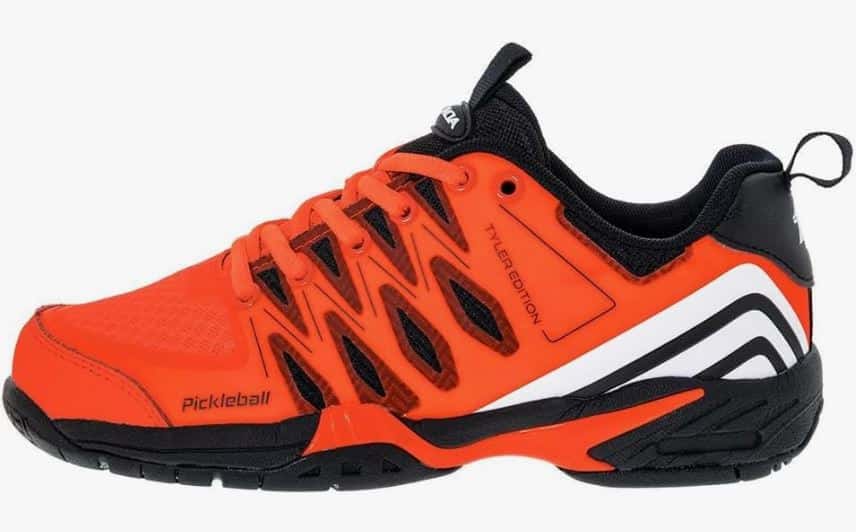
The Acacia Sports Tyler Loong Signature Edition Pro offers speed-focused performance with court-ready traction and support for intermediate to advanced players.
Built for agility, the non-marking outsole grips well on indoor and outdoor courts. Its ARK-Technology midsole resists moisture and reinforces underfoot structure.
A silicone honeycomb insole cushions the heel and forefoot during rapid steps, while antimicrobial properties reduce odor buildup during extended sessions.
The shoe’s design focuses on lateral control. A ProFlex membrane frame combines with ballistic nylon for flexible but stable motion.
A wider toe box accommodates foot splay during quick stops, while the elevated heel helps reduce rolling risk during diagonal lunges. The patterned tread performs well on dry courts, offering confident traction during short sprints and pivots.
Durability comes from the leather drag guard and reinforced sole edge. These features protect high-friction zones from court wear, helping extend the lifespan through frequent matches.
The upper remains breathable despite structural layers, maintaining temperature regulation and minimizing interior heat buildup.
The shoe’s low-profile design supports quick transitions without excessive bulk. Those prioritizing mobility over high-stack cushioning will benefit most from this model. However, players seeking deeper heel padding or wide-foot support beyond the toe box may find the fit limited.
At $100+, the shoe justifies its cost for players needing speed and grip over long-wear plushness. Its features target movement precision and foot stability, not maximal comfort. While the midsole offers shock reduction, overall cushioning remains moderate compared to high-comfort shoes.
The Acacia Tyler Loong Signature Edition Pro suits competitive players who prioritize foot speed, directional control, and slip resistance. It’s best for short bursts of play rather than extended sessions requiring thick underfoot padding.
5. Skechers Viper Court Pickleball Shoe: Expensive Pick

The Skechers Viper Court Pro delivers court-specific support with podiatrist-certified arch structure, ideal for multi-day pickleball sessions. It offers strong lateral stability and traction for both indoor and outdoor courts.
Tested over two hours on outdoor surfaces, the outsole gripped reliably during quick directional shifts. Its rubber base enhances balance during split-step actions and short sprints.
The cushioned insole adapts to your foot shape while offering arch relief for high-arched users. The shoe includes medium and extra-wide fit options, which allow space for swelling or orthotic inserts. Its looser structure makes it more forgiving than narrow-performance designs.
The Viper features a tough rubber outsole for abrasion resistance and consistent ground contact. Stability during explosive movements is aided by midsole responsiveness, helping absorb pressure without losing foot control. Despite its slightly bulkier build, testers found it smooth during extended court sessions.
Its solid grip, responsive base, and removable insole make it viable for cross-training or tennis. A padded tongue minimizes friction, reducing the risk of top-foot blisters. While breathability is limited due to the upper material, players focused on joint protection and all-surface reliability will find consistent value.
At just over $110, the Viper Court Pro balances cost with robust court performance and medically-backed comfort. Skechers’ support-first approach pays off for players needing ankle and knee cushioning during high-volume play.
Best for wide-foot players and those needing arch reinforcement, the Viper Court Pro fits users who prioritize injury prevention, stability, and all-around court control.
Factors to Consider When Buying Anti-Slip Pickleball Shoes
1: Outsole Design & Traction Technology
The foundation of any anti-slip pickleball shoe lies in its outsole construction. Research in sports biomechanics has demonstrated that specialized tread patterns significantly impact court grip and injury prevention.
Look for non-marking rubber compounds with herringbone or modified herringbone patterns that provide optimal grip during lateral movements, while circular or hexagonal patterns enhance multidirectional traction.
Studies on court surface interaction show that proper outsole design can reduce slip incidents by up to 40% compared to inappropriate footwear. Avoid running shoes with deep lugs that can catch on court surfaces and cause instability.
Lateral Support & Stability Features
Pickleball’s rapid direction changes demand robust lateral support systems based on established biomechanical principles.
Multiple studies in sports medicine have confirmed that ankle bracing is effective for primary and secondary prevention of acute ankle injuries in athletes, with similar principles applying to shoe-based lateral support.
Quality pickleball shoes incorporate reinforced sidewalls, TPU heel counters, and structured midsole technology to prevent ankle rolling during aggressive side-to-side movements.
Research indicates that proper lateral support can reduce the risk of ankle sprains—the most common court sport injury—by providing enhanced stability during rapid directional changes.
Weight Distribution & Responsiveness
Optimal weight balance directly affects court agility and fatigue levels during extended play, as supported by biomechanical studies on athletic performance.
Sports science research has shown that shoe weight directly correlates with energy expenditure and movement efficiency during court sports.
Ultra-lightweight shoes enhance quick footwork and reduce energy expenditure, making them ideal for competitive players.
However, ensure lightweight construction doesn’t compromise durability or support, as studies indicate that inadequate support can increase injury risk despite improved agility.
Court Surface Compatibility
Different court surfaces require specific traction considerations based on friction coefficient research.
Studies analyzing court surface interaction demonstrate that outdoor (asphalt) and indoor (wood laminate) courts play differently, requiring different rubber compounds for optimal performance.
Hard courts demand durable rubber compounds that resist abrasion, while indoor courts may require softer rubber formulations for better grip.
Fit & Comfort Features
Proper fit is crucial for preventing blisters and maintaining stability during play.
Pickleball shoes should provide a snug heel fit with adequate toe room for forward movement.
Consider models with moisture-wicking linings, breathable upper materials, and removable insoles if you require custom orthotics for additional support.
Our Verdict on the best anti-slip shoes for pickleball
Based on our comprehensive analysis of anti-slip pickleball shoes, the Acacia Tyler Loong Signature Edition Pro emerges as the clear winner for serious players who refuse to compromise on court performance.
With its very high traction rating and superior lateral stability, the Acacia Tyler Loong Signature Edition Pro shoe delivers exactly what competitive pickleball demands—lightning-fast directional changes without the fear of slipping.
Every slip, every unstable step, every moment of hesitation on the court is a point handed to your opponent. The Tyler Loong Pro’s antimicrobial properties and durable construction mean you’ll maintain peak performance match after match, while lesser shoes break down and compromise your game.
FAQs
Can I use tennis shoes for pickleball instead of specialized pickleball shoes?
While tennis shoes work, pickleball shoes offer superior lateral support and court-specific traction patterns. Tennis shoes are designed more for forward/backward movement, while pickleball demands extensive side-to-side motion.
What’s the difference between indoor and outdoor pickleball shoes?
Indoor shoes use softer rubber compounds for better grip on smooth surfaces, while outdoor shoes feature harder, more durable rubber to withstand abrasive concrete courts. Many modern shoes work well on both surfaces.
How often should I replace my pickleball shoes?
Replace shoes every 300-500 hours of play or when the outsole tread wears smooth. Loss of traction is a safety hazard and performance killer.
Do I need wide-width pickleball shoes?
If you have wide feet or experience pressure on the sides during play, yes. The Skechers Viper Court Pro offers the best wide-width options among quality pickleball shoes.
What makes a shoe truly “anti-slip” for pickleball?
Specialized rubber compounds, herringbone or multidirectional tread patterns, and non-marking outsoles designed specifically for court surfaces. Running shoe treads actually increase slip risk on courts.
Are expensive pickleball shoes worth the investment?
For regular players, yes. Quality shoes prevent injuries, improve performance, and last longer. A $100+ shoe that prevents one ankle injury pays for itself immediately.
Should pickleball shoes feel tight or loose?
Snug heel fit with 1/2 inch toe room. Too tight causes blisters; too loose creates instability during lateral movements and increases injury risk.
Can I use running shoes for pickleball?
No, running shoes have forward-motion designs and deep lugs that catch on courts, causing falls. They lack the lateral support essential for pickleball safety.

It’s me Joe, a devoted pickleball enthusiast, and an avid player, I’m passionate about sharing the joy and excitement of the game through my Pickle Ball Routine. With years of experience on the court, I have honed my skills, explored various strategies, and developed a deep understanding of the nuances of pickleball.
I believe in the power of community and the incredible connections that can be forged through pickleball. I have had the privilege of engaging with players of all levels, from beginners seeking guidance to seasoned athletes looking to enhance their gameplay. My friendly and approachable demeanor makes me a valuable resource for players of all backgrounds.
Through Pickle Ball Routine, I aim to inspire and educate fellow pickleball enthusiasts. By sharing personal experiences, tips, techniques, and stories from the game, I strive to create a platform that fosters growth, camaraderie, and an unyielding passion for pickleball.
